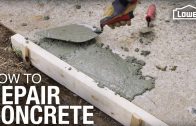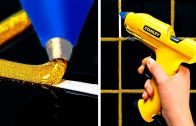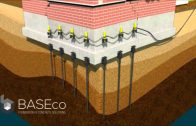How to Fix Common Leaks | Basic Plumbing
Watch more Basic Plumbing videos: http://www.howcast.com/videos/513656-How-to-Fix-Common-Leaks-Basic-Plumbing
Okay. So I’m going to talk for a few minutes about how to fix some of the most common plumbing leaks that you might see in your home or business. Okay. But first, before I go into that I should talk about the types of joints that you have. When we say “joints” in the plumbing world, we’re talking about connections between pipes of like or unlike materials. So one of the most common is what we call an IPS joint. IPS stands for iron pipe size, this being an iron pipe. This is most likely found in gas, which is a no-no, so stay away from it. But this also translates to other pipes, too. You could have a brass pipe, all right, exactly the same as this, which is called a nipple, but this would be made out of brass. That would found in a water distribution system. Okay.
This is a three-quarter IPS steel nipple. You could just as samely have a three-quarter IPS brass nipple. So let’s just assume that this nipple is brass. Okay. And when you have a leak on something like this, as long as it’s not decayed or old or banged-up or dented or otherwise destroyed, okay, you can seal that leak by doing two things. One is Teflon tape. Okay. This is a non-sticky type of sealing tape. Okay. I always try to take the first few inches of it off and get rid of it, because it’s been dusty. Okay. What you want to do is you can see that tape is just kind of laid on the tip of my finger. I would take the pipe that I’m going to be sealing and wrap the tape around it three times. One, in the direction of the joint so turning clockwise, two, three.
A lot of amateurs and homeowners will try to mummify the threads of these things in tape. It’s just not necessary. Three is the number. Now that could actually serve. That could be enough. But I also like to use pipe dope, the amusingly named pipe dope, or pipe thread sealant. Okay. And again, same as in my video about soldering a joint, you don’t need a ton of this stuff. The first three threads are more than enough. When you take your Master Plumber’s exam with the City of New York, they’ll actually fail you for using too much of this.
Okay. Just kind of go gently around, and make sure that you’ve got a film of it on these threads. So now you’ve got a sealed joint. Okay. Now if we were taking this, and if it were brass and we’re screwing it into a fitting in the wall, we’re turning it clockwise into the fitting. And you’re going to feel it stop. It’s going to be too much for your hands to do. That’s when your trusty Channel Locks come in or a wrench. You would grab down and turn it in. A lot of people use the Incredible Hulk type strength to turn these things in. It’s not necessary. These thread, you can see this side better, they’re tapered. Okay. As you turn a nipple in, and IPS nipple in, those threads will bury into the fitting. You’ll leave about four threads. It’s enough. It’s enough.
You don’t need to kill it. You don’t need to put it in there like it’s never, ever going to come out of there again. Just snug is good. If you have to do it more than that, there’s something wrong. Maybe you’ve damaged the threads, or maybe the fitting is bad. Maybe the threads are damaged. So you don’t need to kill it putting it in there. That’s an IPS joint. Another type of joint that you will see in the plumbing system is a compression joint. Now a compression joint works in a very, very different mechanism. Okay. This here is what we call a three-eighths compression coupling, coupling meaning it joins two sections of three-eighths pipe together. All right. This works on a nut-and-ferrule system. This is the nut, and the ferrule, this little brass ring. What happens with this type of joint, notice the threads are only in this nut to hold the ferrule down to the pipe.
It’s kind of a neat way of working. They call it compression because when you slip this nut over the pipe, followed by the ferrule, now we’re over a pipe and we’re going to thread it onto this coupling. Okay. As you turn this nut down, that brass ring, that brass ferrule inside actually crushes down to the pipe wall. And it crushes down so tight that it effectively makes one piece of pipe. Once you crush the ferrule down to the pipe, it’s on the pipe forever. If you need to make a repair, you have to get rid of it, cut in another joint, and then fix it that way.
But that’s another type of joint. So this would be the other side. You’d put your nut over the pipe first, followed by the ferrule. You thread it on, and then you would kind of hold that with two pair of Channel Locks or two adjustable wrenches, and just join that together. It’s a very, very tight what we call a mechanical joint. This is a mechanical joint. The l


























